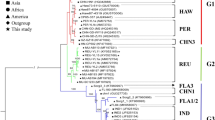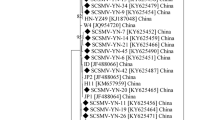Abstract
Sweetpotato leaf curl virus (SPLCV) is a species of virus that causes substantial yield losses in sweetpotato. In this study, twenty-four complete genomic sequences of SPLCV which identified from the sweetpotato samples collected from China, were calculated into four strains. A total of 11.9% isolates were recombinants, and ten recombination patterns were detected. In addition to C3, V1, IR and C1 genes, the both ends of the V2 gene were also identified as recombination hot spots for SPLCV. Negative (purifying) selection was identified among all six SPLCV genes, except for C4 gene was under the variety of choices (positive selection) for adaptive protein evolution. The mismatch distribution of SPLCV in all subgroups and groups was multiple peaked or ragged, indicating SPLCV population has existed for a long time. The gene flows between Shandong, Hebei and Jiangsu Provinces in China were frequent, which was also observed between the groups of China, Brazil, South Korea. Recombination, selection pressure and gene flow promote the evolution of the SPLCV in China.



Similar content being viewed by others
References
Adams MJ, Lefkowitz EJ, King AMQ, Harrach B, Harrison RL, Knowles NJ, Kropinski AM, Krupovic M, Kuhn JH, Mushegian AR, Nibert M, Sabanadzovic S, Sanfaçon H, Siddell SG, Simmonds P, Varsani A, Zerbini FM, Gorbalenya AE, Davison AJ (2016) Ratification vote on taxonomic proposals to the International Committee on Taxonomy of Viruses. Adv Virol 161(10):2921–2949
Albuquerque LC, Inoue-Nagata AK, Pinheiro B, Ribeiro SG, Resende RO, Moriones E, Navas-Castillo J (2011) A novel monopartite begomovirus infecting sweetpotato in Brazil. Arch Virol 156:1291–1294
Albuquerque LC, Inoue-Nagata AK, Pinheiro B, Resende RO, Moriones E, Nava-Castillo J (2012) Genetic diversity and recombination analysis of sweepoviruses from Brazil. Virol J 9(1):241
Bi H, Zhang P (2012) Molecular characterization of two sweepoviruses from china and evaluation of the infectivity of cloned SPLCV-JS in Nicotiana Benthamiana. Adv Virol 157(3):441–454
Briddon RW, Bull SE, Bedford ID (2006) Occurrence of sweetpotato leaf curl virus in sicily. Plant Pathol 55(2):286
Clark CA, Valverde RA, Fuentes S, Salazar LF, Moyer JW (2002) Research for improved management of sweetpotato pests and diseases: cultivar decline. Acta Hort 583:103–112
Clark CA, Davis JA, Abad JA, Cuellar WJ, Fuentes S, Kreuze JF, Gibson RW, Mukasa SB, Tugume AK, Tairo FD, Valkonen JP (2012) Sweetpotato viruses: 15 years of progress on understanding and managing complex diseases. Plant Dis 96(2):168–185
Cuellar WJ, Galvez M, Fuentes S, Tugume J, Kreuze J (2015) Synergistic interactions of begomoviruses with sweetpotato chlorotic stunt virus (genus crinivirus) in sweetpotato (ipomoea batatas l). Mol Plant Pathol 16(5):459–471
Fialloolivé E, Katis NI, Navascastillo J (2014) First report of sweetpotato leaf curl virus on blue morning glory in greece. Plant Dis 98(5):700
Fuentes S, Salazar LF (2003) First report of sweetpotato leaf curl virus in Peru. Plant Dis 1:98
Gao F, Gong Y, Zhang P (2000) Production and deployment of virus-free sweetpotato in china. Crop Protection 19(2):105–111
García-Arenal F, McDonald BA (2003) An analysis of the durability of resistance to plant viruses. Phytopathology 93(8):941–952
Haible D, Kober S, Jeske H (2006) Rolling circle amplication revolutionizes diagnosis and genomics of geminiviruses. J Virol Methods 135(1):9–16
Huang X, Wang Y, Yan Z, Geng C, Tian Y, Li X (2019) Screening and application of attenuated mutants of Papaya ringspot virus-watermelon strain. J Plant Protect 46(4):738–744
Jawad AA, Ayyez HN, Kleaf SF (2018) Sequencing and phylogeny of sulphonamide resistant genes by using MEGA6 software program. Int J Res Pharm Sci 9(SPL1):56
Kim J, Kil E, Kim S, Seo H, Byun H, Park J, Chung MN, Kwak HR, Kim MK, Kim CS, Yang JW, Lee KJ, Chol HS, Lee S (2016) Seed transmission of sweetpotato leaf curl virus in sweetpotato (Ipomoea Batatas). Plant Pathol 64(6):1284–1291
Latham JR, Saunders K, Pinner MS, Stanley J (1997) Induction of plant cell division by beet curly top virus gene C4. Plant J 11(6):1273–1283
Lefeuvre P, Lett JM, Reynaud B, Martin DP (2007) Avoidance of protein fold disruption in natural virus recombinants. PLoS Pathog 3:181
Lefeuvre P, Lett JM, Varsani A, Martin DP (2009) Widely conserved recombination patterns among single-stranded DNA viruses. J Virol 83:2697–2707
Li R, Salih S, Hurtt S (2004) Detection of geminiviruses in sweetpotato by polymerase chain reaction. Plant Dis 88(12):1347–1351
Li X, Zhu T, Yin X, Zhang C, Chen J, Tian Y, Liu J (2017) The genetic structure of Turnip mosaic virus population reveals the rapid expansion of a new emergent lineage in China. Virol J 14(1):165–174
Librado P, Rozas J (2009) Dnasp v5: a software for comprehensive analysis of DNA polymorphism data. Bioinformatics 25:1451–1452
Liu Q, Wang Y, Zhang Z, Lv H, Qiao Q, Qin Y, Zhang D, Tian Y, Wang S (2017) Diversity of sweepoviruses infecting sweetpotato in china. Plant Dis 101(12):2098–2103
Lotrakul P, Valverde RA, Clark CA, Sim J, De la RT (1998) Detection of a geminivirus infecting sweetpotato in the United States. Plant Dis 82:1253–1257
Lozano G, Trenado HP, Valverde RA, Castillo JN (2009) Novel begomovirus species of recombinant nature in sweetpotato (Ipomoea batatas) and Ipomoea indica: taxonomic and phylogenetic implications. J Gen Virol 90:2550–2562
Luan YS, Zhang J, An LJ (2006) First report of Sweetpotato leaf curl virus in China. Plant Dis 90:1111
Luan YS, Zhang J, Liu DM, Li WL (2007) Molecular characterization of sweetpotato leaf curl virus isolate from China (SPLCV-CN) and its phylogenetic relationship with other members of the Geminiviridae. Virus Genes 35:379–385
Maina S, Miano DW, Mbogo E, Amimo JO, Irungu J, Njiruh PN (2017) Occurrence and genetic variability of partial coat protein gene of sweetpotato leaf curl virus (SPLCV) in Kenya. Afr J Biotech 16(45):2112–2120
Martin DP, Murrell B, Khoosal A, Muhire B (2017) Detecting and analyzing genetic recombination using rdp4. Methods Mol Biol 1525:433–460
Mohammed HS, Siddig MARE, Hussein AAE, Ibrahim FA, Navas-Castillo J, Fiallo-Olivé E (2017) First report of sweetpotato leaf curl virus infecting sweetpotato in sudan. Plant Dis 101(5):849
Muhire MB, Martin DP, Brown JK, Navas-Castillo J, Moriones E, Zerbini FM, Rivera-Bustamante R, Malathi VG, Briddon RW, Varsani A (2013) A genome-wide pairwise-identity-based proposal for the classification of viruses in the genus Mastrevirus (family Geminiviridae). Arch Virol 158:1411–1424
Ohshima K, Yamaguchi Y, Hirota R, Hamamoto T, Tomimura K, Tan Z, Sano T, Azuhata F, Walsh JA, Fletcher J, Chen J, Gera A, Gibbs A (2002) Molecular evolution of Turnip mosaic virus; evidence of host adaptation, genetic recombination and geographical spread. J Gen Virol 83:1511–1521
Paprotka T, Boiteux LS, Fonseca MEN, Resende RO, Jeske H, Faria JC, Ribeiro SG (2010) Genomic diversity of sweetpotato geminiviruses in a Brazilian germplasm bank. Virus Res 149:224–233
Pardina PR, Nome C, Colomba EL, Delgado SF, Feo LD (2012) First report of sweetpotato leaf curl virus infecting sweetpotato in Argentina. Australasian Plant Dis Notes 7(1):157–160
Park J, Hwang HS, Buckley KJ, Park JB, Auh CK, Kim DG, Lee S, Davis KR (2010a) C4 protein of beet severe curly top virus is a pathomorphogenetic factor in arabidopsis. Plant Cell Rep 29:1377–1389
Park J, Hwang HS, Buckley KJ, Park JB, Auh CK, Kim DG, Lee S, Davis KR (2010b) C4 protein of Beet severe curly top virus is a pathomorphogenetic factor in Arabidopsis. Plant Cell Rep 29(12):1377–1389
Park J, Kim S, Choi E, Kwak HR, Kim MK, Lee KY, Choi HS, Lee S (2011) Molecular characterization of sweetpotato leaf curl virus (SPLCV) isolates from Korea: phylogenetic relationship and recombination analysis. Acta Virol 55(4):327–335
Prasanna HC, Rai M (2007) Detection and frequency of recombination in tomato-infecting begomoviruses of South and Southeast Asia. Virol J 4:111
Rubio L, Angeles M, Ayllón A, Kong P, Fernándes A, Polek M, Guerri J, Moreno P, Falk BW (2001) Genetic variation of Citrus tristeza virus isolates from California and Spain: evidence for mixed infections and recombination. J Virol 75:8054–8062
Thompson JD, Gibson TJ, Plewniak F, Jeanmougin F, Higgins DG (1997) The clustal_x windows interface: flexible strategies for multiple sequence alignment aided by quality analysis tools. Nucleic Acids Res 24:4876–4882
Tian YP, Liu JL, Zhang CL, Liu YY, Wang B, Li XD, Guo ZK, Valkonen JP (2011) Genetic diversity of Potato virus Y Infecting tobacco crops in China. Phytopathology 101:377–387
Tomitaka Y, Ohshima K (2006) A phylogeographic study of the Turnip mosaic virus population in east Asia reveals an ‘emergent’ lineage in Japan. Mol Ecol 15:4437–4457
Tomitaka Y, Yamashita T, Ohshima K (2007) The genetic structure of populations of turnip mosaic virus in kyushu and central honshu, Japan. J Gen Plant Pathol 73(3):197–208
Xie YP, Xing JY, Li XY, Wang X, Sun HJ, Zhao YQ, Zhang CL, Ma DF (2013) Survey of sweetpotato viruses in China. Acta Virol 57(1):81–84
Yang CX, Wu ZJ, Xie LH (2009) First report of the occurrence of sweetpotato leaf curl virus in tall morning glory (Ipomoea purpurea) in china. Plant Dis 93(7):764
Zerbini FM, Briddon RW, Idris A, Martin DP, Moriones E, Navas-Castillo J, Rivera-Bustamante R, Roumagnac P, Varsani A (2017) ICTV virus taxonomy profile: geminiviridae. J Gen Virol 98(2):131
Zhang SC, Ling KS (2011) Genetic diversity of sweetpotato begomoviruses in the United States and identification of a natural recombinant between sweetpotato leaf curl virus and sweetpotato leaf curl Georgia virus. Adv Virol 156(6):955–968
Acknowledgements
Chengling Zhang and Houjun Sun had full access to all the data in the study, and they take the full responsibility for the integrity of the data and the accuracy of the data analyses; Chengling Zhang helped in study conception and design; Dongjing Yang, Mei Zhang and Yiping Xie contributed to acquisition of data ; Chengling Zhang and Jukui Ma analyzed and interpreted the data. All authors read and approved the final manuscript. This work was supported by the National Key R&D Program of China (Grant Number 2018YFD1000703, 2018YFD1000700), the Jiangsu Provincial Natural Science Foundation, China (grant number BK20140230) and the Earmarked Fund for China Agriculture Research System (Grant Number CARS-10-B15).
Author information
Authors and Affiliations
Corresponding author
Ethics declarations
Conflict of interest
The authors declare that they have no conflict of interest.
Ethical statement
The manuscript is not be submitted to more than one journal. The submitted work is the original and has not been published elsewhere in any form or language. This study is not split up into several parts to increase the quantity of submissions and submitted to various journals or to one journal over time. Concurrent or secondary publication is sometimes justifiable, and provided certain conditions are met.
Human and animal rights
This article does not contain any studies with human participants or animals performed by any of the authors. This article is distributed under the terms of the Creative Commons Attribution 4.0 International License (http://creativecommons.org/licenses/by/4.0/), which permits unrestricted use, distribution and reproduction in any medium, provided you give appropriate credit to the original author(s) and the source, provide a link to the Creative Commons license and indicate if changes were made.
Additional information
Publisher's Note
Springer Nature remains neutral with regard to jurisdictional claims in published maps and institutional affiliations.
Electronic supplementary material
Below is the link to the electronic supplementary material.
Rights and permissions
About this article
Cite this article
Zhang, C., Sun, H., Xie, Y. et al. The genetic structure and recombination analyses of Sweetpotato leaf curl virus (SPLCV) population in China. J Plant Dis Prot 127, 741–751 (2020). https://doi.org/10.1007/s41348-020-00348-4
Received:
Accepted:
Published:
Issue Date:
DOI: https://doi.org/10.1007/s41348-020-00348-4




